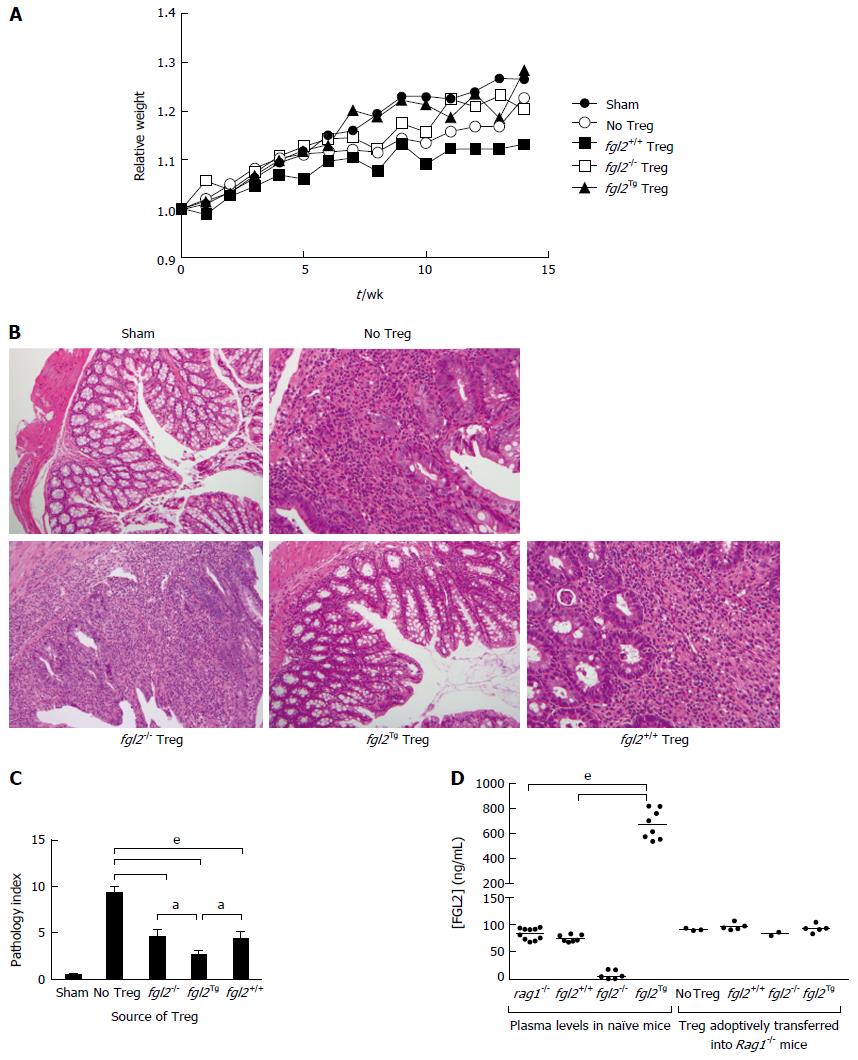Copyright
©The Author(s) 2017.
World J Gastroenterol. Apr 21, 2017; 23(15): 2673-2684
Published online Apr 21, 2017. doi: 10.3748/wjg.v23.i15.2673
Published online Apr 21, 2017. doi: 10.3748/wjg.v23.i15.2673
Figure 3 fgl2Tg Treg protect against colitis.
A: Effect of Treg on clinical course of disease as determined by weight. Mice were weighed weekly and were sacrificed at 14 wk post cell transfer. Mice that received fgl2Tg Treg gained weight similar to the sham group of mice, whereas all other groups had reduced weight gain (n ≥ 5 mice/group); B: Histology of colons. Sham colons had normal villous architecture with abundant goblet cells. Colons from the no Treg group showed prominent features of severe colitis with dense cellular infiltration, edema, and abscess formation as well as loss of goblet cells. Infusion of fgl2-/- or fgl2+/+ Treg led to overall improved histology; however, numerous areas of patchy colonic disease were still seen. In contrast, colons from mice that received fgl2Tg Treg were near normal. H&E; Original magnification 100 ×; C: Pathologic scoring of colon sections. Scoring was performed on H&E stained sections as described in the methods section. Data represent mean ± SEM. Pathology scores were obtained from 2 independent experiments with n ≥ 5 mice per group; D: Transfer of fgl2Tg Treg does not alter FGL2 plasma levels during colitis. Blood from fgl2+/+, Rag1-/- and, fgl2Tg mice was collected prior to the induction of colitis (plasma levels in naïve mice). At sacrifice, blood was collected from each animal. Rag1-/- mice received CD4+CD25-CD45RBhi T cells and Treg isolated from fgl2+/+ or fgl2Tg mice (Treg adoptively transferred into Rag1-/- mice). Plasma levels of FGL2 were measured using an FGL2 ELISA. Statistical analysis was performed using a one-way ANOVA and Tukey’s multiple comparison post-hoc test (aP < 0.05, eP < 0.001). Treg: Regulatory T cells.
- Citation: Bartczak A, Zhang J, Adeyi O, Amir A, Grant D, Gorczynski R, Selzner N, Chruscinski A, Levy GA. Overexpression of fibrinogen-like protein 2 protects against T cell-induced colitis. World J Gastroenterol 2017; 23(15): 2673-2684
- URL: https://www.wjgnet.com/1007-9327/full/v23/i15/2673.htm
- DOI: https://dx.doi.org/10.3748/wjg.v23.i15.2673









